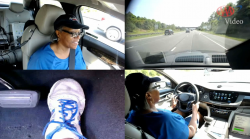
— Active driving assistance systems have made progress with regulators and auto safety advocates, but those systems seem to be giving drivers a false sense of security that could cause crashes, not prevent them.
A previous survey conducted by AAA showed that 40% of consumers expected the systems, with system names such as Autopilot and ProPILOT, to have the ability to drive the cars without input from drivers.
Now new research conducted by the AAA Foundation for Traffic Safety indicates automakers are causing consumers to forget the limitations of active driving assistance systems.
Researchers found the names of the systems and the marketing used to advertise the systems confuse consumers concerning the capabilities and convenience of the systems.
Advertising that suggests "automated" driving is possible can cause drivers to forget the limitations of the technology, leading to dangerous driving conditions for everyone on the roads.
“These systems assist the driver and take some of the stress out of driving, but they don’t eliminate the need for drivers to pay attention.” - Dr. David Yang, executive director of the AAA Foundation for Traffic Safety
AAA recruited 90 participants for the research and provided them an overview of a realistic active driving assistance system, but the system name was fictitious.
Half of the participants were told their system was called “AutonoDrive,” and they were given "upbeat training" that emphasized the system’s capabilities and the convenience of using the systems.
But the other half of the participants were told their system was named “DriveAssist,” and researchers say the training placed greater emphasis on the system’s limitations and driver responsibility.
The drivers training with AutonoDrive had greater confidence in the systems, and researchers found some of those drivers had too much confidence. After the training was concluded and after driving the test vehicle, 42% of the participants using AutonoDrive said its name made the system sound more capable than it was.
In comparison, only 11% of DriveAssist users felt the same way.
AAA researchers say they understand automakers are in business to manufacture, market and sell vehicles, and to do that an automaker will focus on the alleged convenience and capabilities of driving assistance systems. But words have meaning, and car companies need to use words that won't give drivers a false sense of security or false expectations.
Safety researchers advise owners to read the owner's manuals to learn the limitations of the systems, limitations that may not be mentioned in advertising for the vehicles. Additionally, leave out the assumptions about the driver assistance systems and recognize the differences between active driving systems and self-driving systems.




